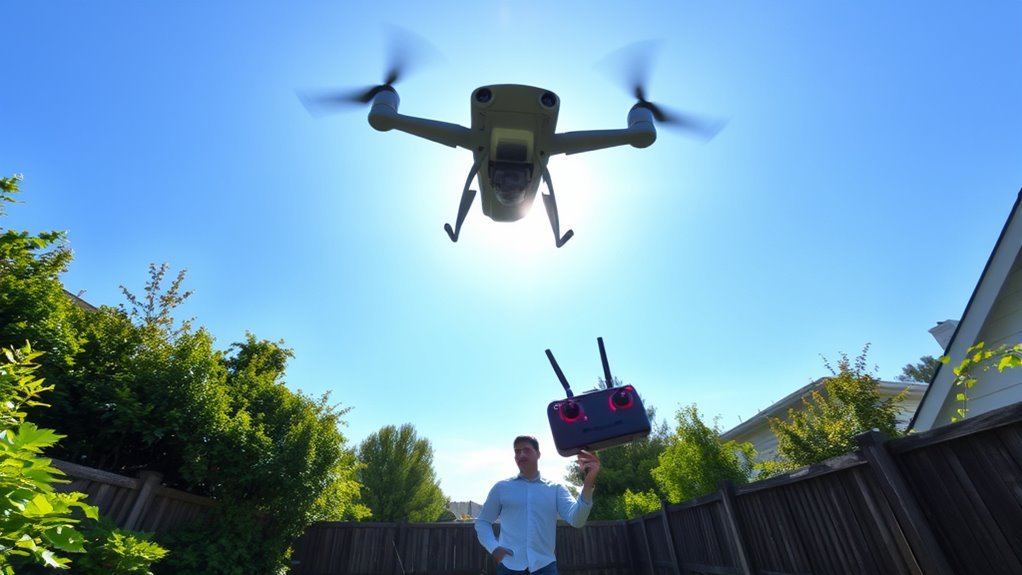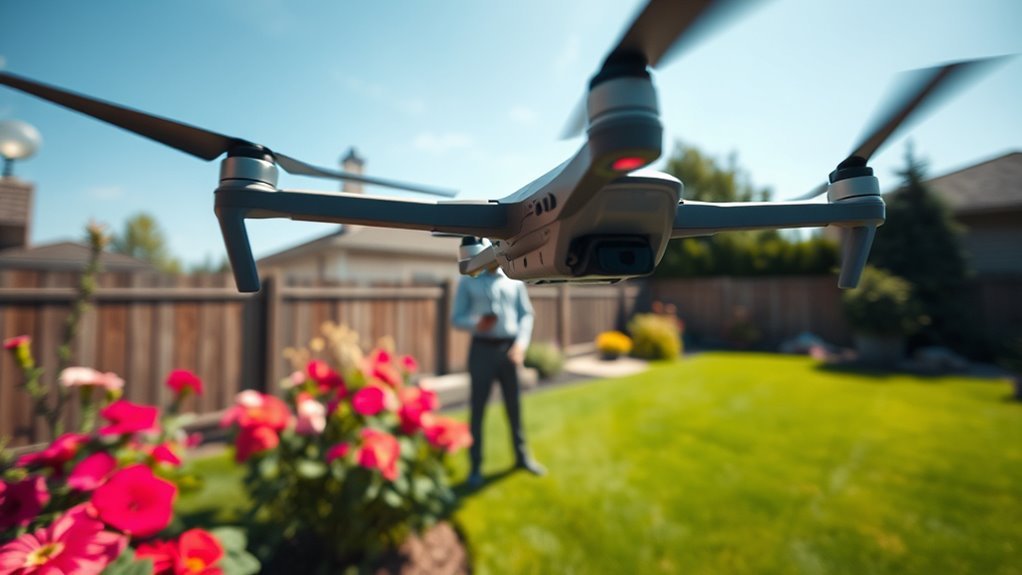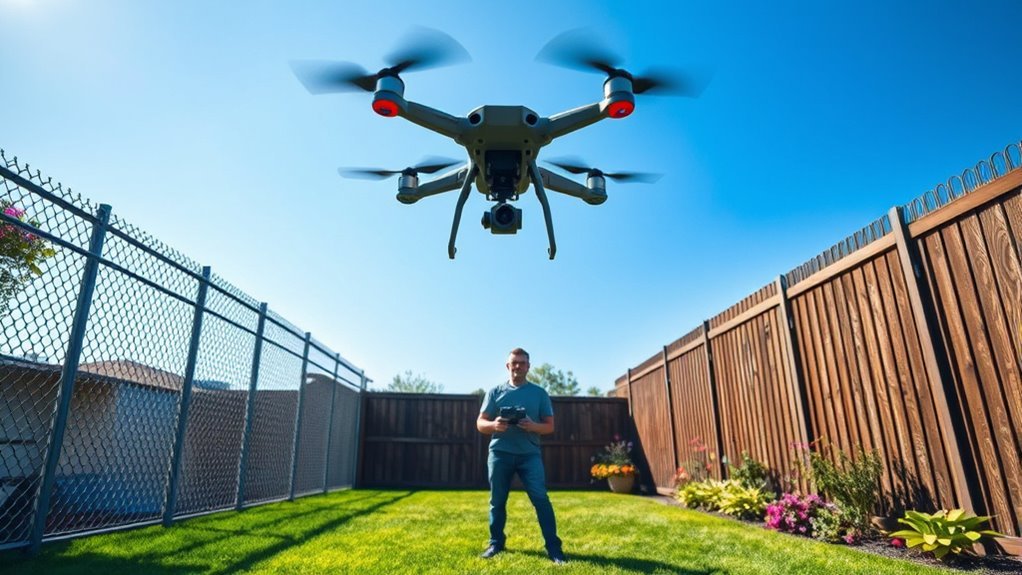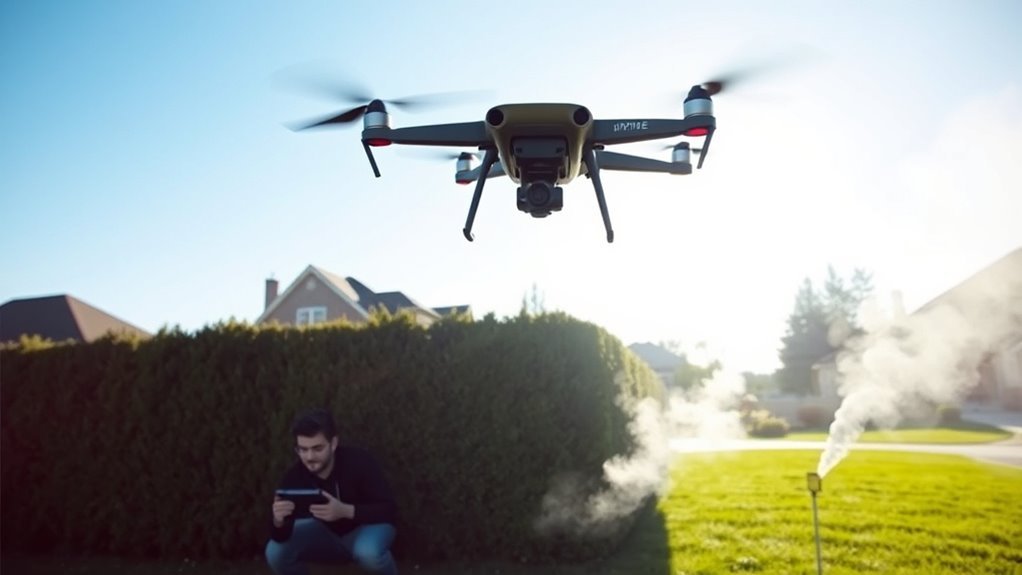You can’t just disable drones flying over your property without considering legal limits—airspace is federally regulated, and jamming or shooting down drones may lead to serious penalties. Instead, start by identifying unauthorized drone activity through signal detection or visual monitoring. Use physical barriers like overhead netting to deter intrusions safely. If problems persist, document flights carefully and report to authorities. For precise control and advanced methods, expert consultation is essential to navigate technical and legal complexities effectively.
Understanding Drone Laws and Airspace Rights

Before you consider disabling a drone, you need to understand the legal framework governing drone operations and airspace rights. Drone regulations vary, but generally, the airspace above your property is regulated by federal authorities, not owned outright by property owners. This means your control over drones flying overhead is limited. While you have rights to the immediate airspace necessary for the use and enjoyment of your land, these rights do not extend infinitely upward. Federal drone regulations prioritize safety and privacy but restrict individual actions against drones. To act within the law, you must navigate airspace ownership boundaries carefully and recognize that unauthorized interference can lead to legal repercussions. Knowing these limits guarantees your pursuit of freedom respects the established regulatory environment.
Identifying Unwanted Drone Activity Over Your Property

How can you determine if a drone is intruding on your privacy or property? Start by employing reliable drone identification methods, such as using apps or devices that detect drone signals and model types. Observing flight patterns is essential; unauthorized drones often hover repeatedly or follow predictable routes over sensitive areas like your yard or windows. Pay attention to altitude changes and timing—consistent low-altitude flights during private moments signal intrusion. Document these patterns meticulously to establish a clear record. Understanding these behaviors empowers you to distinguish between casual hobbyist drones and deliberate surveillance attempts. By accurately identifying unwanted drone activity, you assert your right to privacy and freedom, laying the groundwork for appropriate responses without infringing on lawful drone use.
Using Physical Barriers to Deter Drone Intrusion

You can effectively block drones by installing physical barriers like netting or overhead wire systems designed to intercept or deter flight paths. Strategic placement and tension of netting are critical to prevent drones from penetrating protected zones. Additionally, incorporating dense landscape barriers can enhance deterrence by restricting low-altitude access and complicating navigation.
Netting Installation Techniques
Although deploying netting might seem straightforward, effective installation requires careful planning to confirm drones cannot exploit gaps or weak points. Selecting the right netting materials—durable, weather-resistant, and fine-meshed—is critical. Installation methods must confirm tension consistency and secure anchoring around your property’s perimeter to prevent drones from slipping through or damaging the barrier.
| Netting Materials | Installation Methods | Key Considerations |
|---|---|---|
| High-tensile nylon | Tensioned frame setup | Avoid sagging |
| UV-resistant fibers | Anchored support poles | Confirm full coverage |
| Fine mesh weave | Overlapping panel joints | Eliminate entry points |
Overhead Wire Systems
When physical barriers are necessary to prevent drone intrusion, overhead wire systems offer an effective solution by creating a deterrent that drones must navigate or avoid entirely. These aerial drone deterrents consist of strategically tensioned wires installed above your property, forming a physical boundary that disrupts unauthorized drone flight paths. Unlike electronic countermeasures, overhead wire systems provide a passive, reliable defense that doesn’t interfere with other signals or require active monitoring. You’ll appreciate their durability and minimal maintenance, making them a practical choice for securing your airspace. By integrating overhead wire systems, you assert control over your property’s aerial domain, safeguarding your freedom from unwanted surveillance or intrusion while maintaining lawful compliance. This method stands out as a straightforward, effective physical barrier against persistent drone threats.
Landscape Barriers Effectiveness
Since drones rely heavily on clear flight paths, integrating landscape barriers can greatly disrupt their approach and operation. Thoughtful landscape design allows you to create effective physical deterrents by introducing natural visual obstructions such as dense trees, tall shrubs, or strategically placed trellises. These barriers obscure drone sensors and cameras, complicating navigation and surveillance over your property. Unlike electronic countermeasures, landscape barriers require no power and operate continuously, providing a passive yet reliable layer of defense. However, you should assess your property’s layout to maximize coverage without compromising aesthetics or accessibility. When combined with other methods like overhead wires, landscape design forms a critical component in maintaining your freedom from unwanted drone intrusion through tangible, physical means that diminish drone effectiveness efficiently.
Employing Signal Jammers and Anti-Drone Technology
You need to understand the different types of signal jammers available, from GPS to radio frequency blockers, to effectively disrupt drone operations. However, be aware that deploying these devices often involves strict legal restrictions and potential risks, including interference with other critical communications. Evaluating both the technical capabilities and regulatory framework is essential before employing any anti-drone technology.
Types of Signal Jammers
Although drones rely on various frequencies for communication and navigation, signal jammers specifically target those transmissions to disrupt their operation. You’ll encounter several jammer types, each designed for distinct signal types like GPS, Wi-Fi, and radio frequencies. GPS jammers interfere with location signals, causing drones to lose their positional awareness. Wi-Fi and radio frequency jammers disrupt control and video feeds by overwhelming their channels. Understanding jammer effectiveness depends on your ability to match the jammer to the drone’s signal type. Some advanced jammers cover multiple frequencies simultaneously, offering broader defense. By selecting the right jammer, you maintain your property’s privacy and security, ensuring drones can’t exploit communication gaps. Precision in targeting signal types is key to regaining control and preserving your freedom from unwanted surveillance.
Legal Considerations and Risks
While signal jammers offer effective means to disrupt unauthorized drones, employing such technology isn’t without significant legal implications. You need to understand that interfering with drone signals often violates federal laws, including those enforced by the FCC, exposing you to serious legal consequences. Protecting your drone privacy is vital, but using jammers or anti-drone devices can lead to fines, lawsuits, or even criminal charges. Before acting, assess local regulations carefully and consider alternative measures like privacy screens or authorized drone detection services. Your right to freedom doesn’t override laws designed to maintain airspace safety and communication integrity. Balancing your desire for privacy with legal compliance is essential to avoid unintended liabilities while addressing drone intrusions effectively.
Reporting Unauthorized Drones to Authorities
When encountering unauthorized drones, promptly reporting them to the appropriate authorities is essential for guaranteeing safety and legal compliance. Understanding unauthorized drone definitions helps you identify which drones pose a risk to your property and privacy. Following established drone reporting procedures guarantees your complaint is taken seriously and acted upon efficiently.
- Document the drone’s appearance, behavior, and flight path.
- Note the exact time and location of the incident.
- Contact local law enforcement or aviation authorities.
- Provide clear evidence, such as photos or videos, if possible.
Consulting Professionals for Advanced Drone Mitigation Solutions
If you’re dealing with persistent or sophisticated drone intrusions, consulting professionals for advanced drone mitigation solutions is crucial. You’ll gain access to cutting-edge drone detection systems that provide real-time alerts and identify drone types, enhancing your ability to respond effectively. Professional consultations guarantee that your property’s unique vulnerabilities are assessed, and tailored countermeasures are implemented legally and efficiently. Experts can integrate detection with neutralization technologies, balancing your right to privacy and safety with regulatory compliance. By entrusting specialists, you avoid trial-and-error approaches, assuring swift, precise action against unauthorized drones. Protecting your freedom from unwanted surveillance or disruption requires this level of expertise—don’t hesitate to leverage professional consultations for a thorough, reliable defense strategy.

